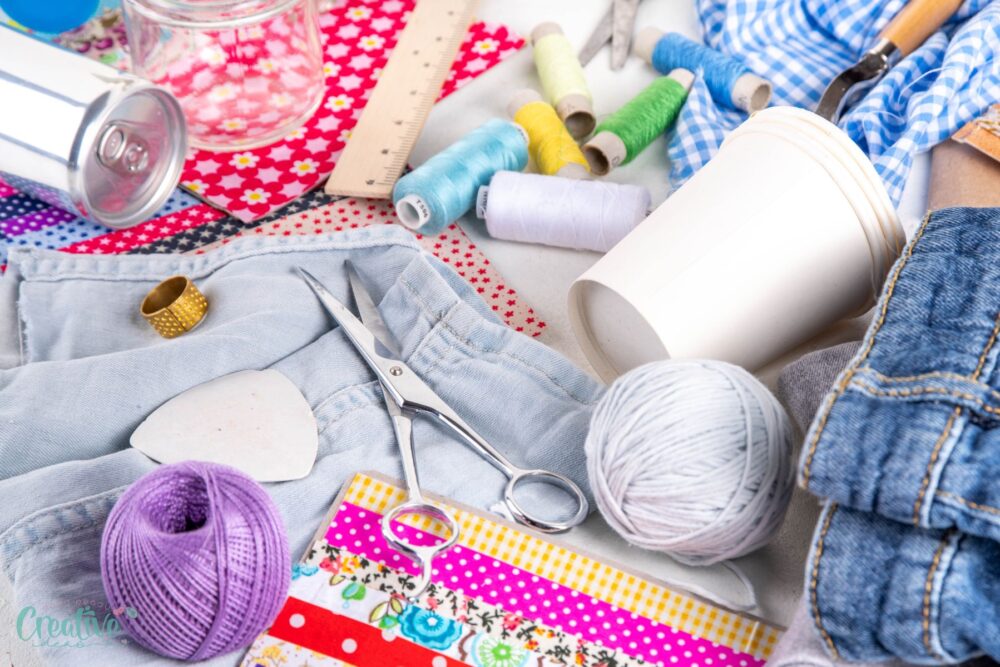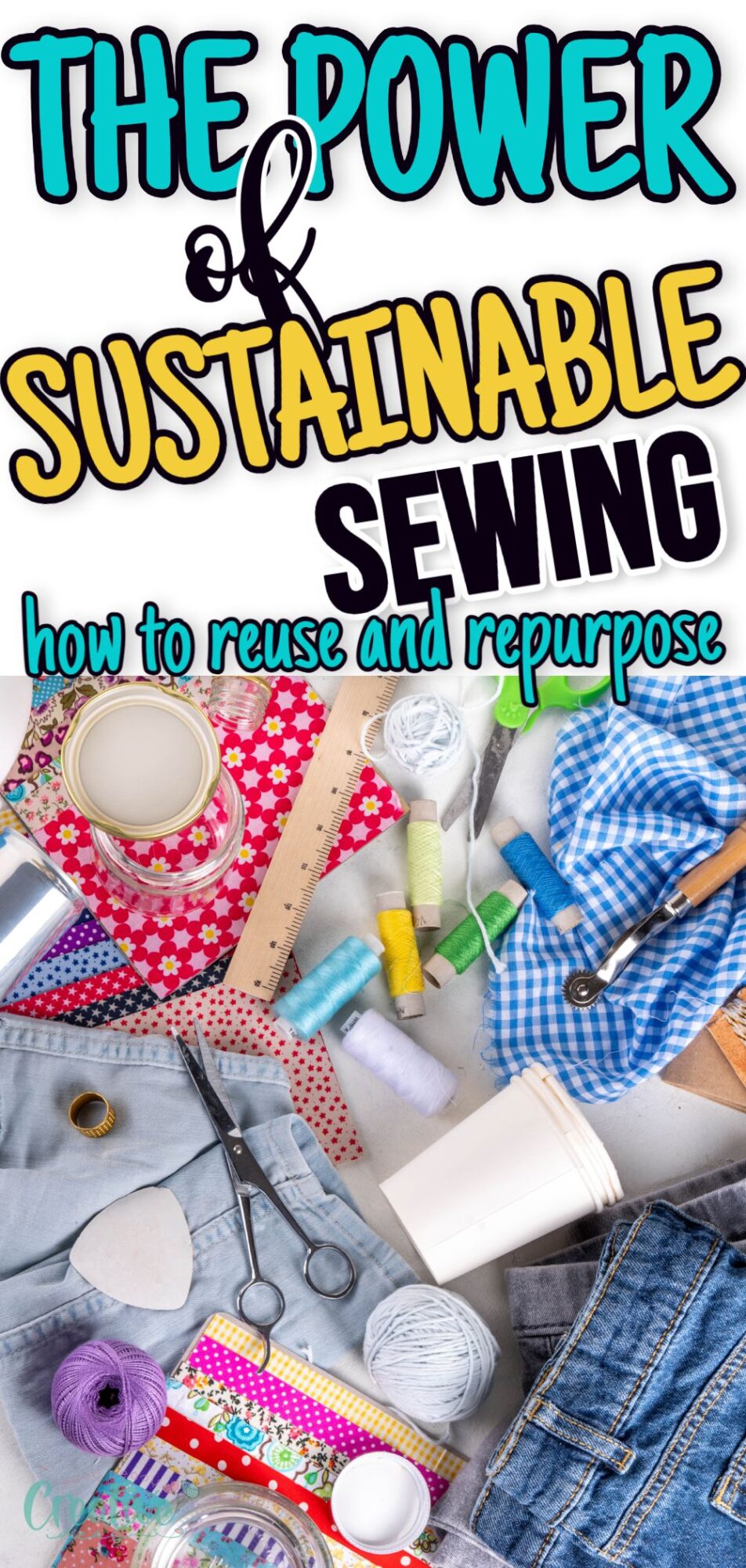14+ Tips for Sustainable sewing: how to reuse and repurpose as a sewist
Sustainable sewing is an empowering approach that not only benefits the environment but also unleashes creativity. I’m a big fan of green sewing and I believe that every stitch counts when it comes to making a positive impact on the planet.
Sewing in itself is an eco-friendly activity as it promotes the use of natural fibers and reduces the consumption of fast fashion. However, the fashion industry is still one of the largest contributors to pollution and waste, from the manufacturing process to the disposal of garments. By incorporating sustainable sewing practices, we can make a difference in reducing this impact.
Sustainable sewing ideas

Sewing with sustainability in mind goes beyond just using eco-friendly materials. Here are a few sustainable sewing tips to help you reuse and repurpose in your sewing projects and get you one step closer to zero waste sewing!
1. Reuse and repurpose fabrics
One excellent way to incorporate sustainability into your sewing projects is of course by reusing and repurposing fabric. Instead of buying new fabric, consider using old clothes, curtains, or other textiles that are no longer in use. Here are some examples from my website:
- For instance, an old canvas pillow cover can be transformed into a trendy tote bag
- Old towels can be quickly turned into cozy cushions for your beloved pets.
- A bed sheet can be used to create a beautiful flutter sleeve dress for yourself or your little girls giving it a new lease on life and reducing textile waste.
- Breathe new life into an old pillowcase by creating a half apron or a full apron.
- Have some old rope? Don’t throw it! Sew it into a nice coiled rope rug for your front door!
- An old jar and a few fabric scraps can be repurposed to create a unique Halloween jar for treats.
- Turn an old placemat into a gorgeous evening purse in just minutes!
- Use a broken measuring tape to create a lunch bag with a snap closure.
- Old t-shirts can be turned into beach coverups or no sew skirts
2. Use up all fabric scraps
Another sustainable practice is to utilize fabric scraps that accumulate from previous projects. Since we have tons of those, we can create unlimited new projects just by repurposing those scraps, even those small batting scraps when you sew them together. Here’s what you can do with them:
- These small pieces can be pieced together to create beautiful patchwork quilts,
- Sew easy and practical potholders for your kitchen needs.
- Or turn the scraps into fabric twine trivets
- Keep the house tidy and organized with some cord organizers
- Greet your guest at holidays with adorable cutlery holders
- Or create unique pieces like these tissue holders.
- Even small bits of quilted scraps can be repurposed into cute Christmas tree ornaments.
3. Don’t throw away selvages
One of my favorite way of sustainable sewing is by making use of the selvage strips. These are the edges of fabric that are usually cut off before sewing. We can save these strips and use them as decorative trims on garments, as straps for bags, toiletry bags, bookmarks or no binding hot pads adding a unique touch to our projects! Or we can create entirely new fabrics by joining those strips together as I did in this tutorial and again here.
4. Reduce waste
In addition to materials and techniques, we can also integrate sustainability into our sewing habits by reducing waste in our workspaces. This includes using scrap paper or old newspapers instead of buying new pattern paper, recycling thread spools, making our own bias bindings instead of purchasing them and properly disposing of needles and pins to avoid them ending up in the environment.
Furthermore, practicing mindful sewing by planning projects carefully and minimizing fabric waste also contributes to sustainability. By planning each detail of our projects ahead, taking accurate measurements and cutting pieces efficiently, we can reduce the amount of fabric that ends up as scraps and save time.
5. Repurpose other materials
But it’s not just the fabrics that can be repurposed, other materials that are typically used outside the sewing projects can also be given a new life. For example, I made some pincushions from recycled materials. This wrist pincushion uses a jar lid as the base, this finger pincushion uses a plastic lid from a bottle as a base while this frame pincushion is made out of a photo frame. For this trio pincushion I used a little piece of twig from my yard to decorate the top and make it look like a pumpkin.
6. Use sustainable materials and fabrics
One way to start sewing sustainably is by choosing materials that are environmentally friendly. This includes using organic cotton or linen instead of conventional cotton which requires large amounts of water and pesticides to produce or using recycled fabrics such as Tencel or bamboo.
7. Reuse old pattern
In addition to materials, you can also make conscious choices when it comes to patterns and designs. Zero waste pattern making involves reusing our old patterns over and over again to create new items. This not only reduces waste but also saves money in the long run. You can also use a basic pattern as a start and modify it to create a variety of garments or items for your home, reducing the need to constantly buy new patterns.
My mom is an old school sewist and she used to modify her old patterns without throwing the cut pieces. Shen then attached the pieces to the rest of the pattern with tape or pins whenever she wanted to recreate the old pattern in the original shape.
8. Fix and reuse old clothes
Furthermore, mending and repairing our clothes instead of throwing them away is an important aspect of sustainable sewing. By extending the life of our garments, we are reducing the amount of textile waste that ends up in landfills. It also allows us to appreciate the value and craftsmanship in each piece we own.
9. Consider the impact of your sewing tools
Sewing sustainably goes beyond just the materials we use. It also involves considering the impact of our sewing machines and tools on the environment. Investing in energy-efficient machines or opting for second-hand ones not only reduces electricity usage but also prevents them from ending up in landfills.
10. Prolong the lifespan of your sewing tools
It’s also essential to properly care for our sewing tools and machines to prolong their lifespan. Regular maintenance and proper storage not only save money in the long run but also reduce the need for replacements.
11. Support local shops
Supporting local fabric shops and artisans can also contribute to sustainability. Not only does this reduce the carbon footprint associated with shipping and logistics, but it also supports local economies and crafts people.
12. Use second hand items
Purchasing materials from thrift stores or second-hand markets is another great way to reduce your environmental impact. Not only do you save money, but you also prevent fabrics from ending up in landfills.
13. Mind the hoarding
Finally, one important aspect of sustainability in sewing is being mindful of our overall consumption. As sewists, we have a tendency to buy more fabric and supplies than we actually need. By carefully planning our projects and only purchasing what we truly need, we can reduce waste and make more conscious choices about the materials we use.
14. Donate or sell unused items
Other examples of sewing with sustainability include donating at charity shops or selling unwanted fabric and sewing supplies instead of throwing them away can reduce waste or using eco-friendly packaging for shipping handmade items.
Additional Tips for Sewing with Sustainability
- Use natural dyes or dye fabric yourself instead of using synthetic dyes that can harm the environment.
- Use eco-friendly and organic thread in your sewing projects.
- Consider using sustainable and biodegradable notions such as wooden buttons, zippers made from recycled materials, or natural fibers for stuffing.
- When possible, choose to hand sew over machine sewing to save energy.
By incorporating these tips and practices into our sewing habits, we can make a positive impact on the environment while still enjoying our favorite hobby. Let’s continue to explore new ways to sew sustainably and inspire others to do the same. Remember, small changes can make a big difference in creating a more sustainable future. Happy stitching!

Article may contain Amazon & affiliate links. As an Amazon Associate I earn from qualifying purchases at no additional cost to you.


ABOUT PETRO
Hi, I’m Petro, author and founder of Easy Peasy Creative Ideas. Sewist, crafter, avid DIY-er, foodie, photographer, homemaker and mommy to one. I’m an expert at coming up with quick, clever sewing tips, recycling crafts and simple, easy recipes! You can find my ideas featured in reputable publications such as Country Living, Good House Keeping, Yahoo News, WikiHow, Shutterfly, Parade, Brit & Co and more. Thanks for stopping by and hope you’ll stay for a while, get to know me better and come back another time. Stick around for real fun projects! Read more…